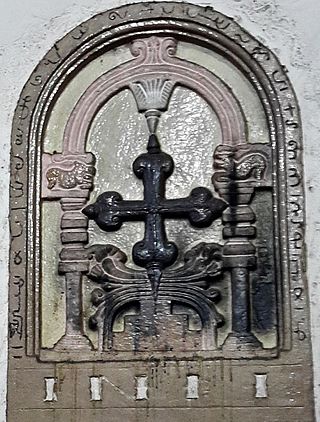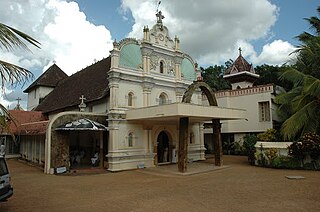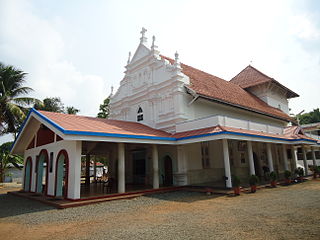
The Malankara Orthodox Syrian Church (MOSC) also known as the Indian Orthodox Church (IOC) or simply as the Malankara Church, is an autocephalous Oriental Orthodox church headquartered in Devalokam, near Kottayam, India. The church serves India's Saint Thomas Christian population. According to tradition, these communities originated in the missions of Thomas the Apostle in the 1st century. It employs the Malankara Rite, an Indian form of the West Syriac liturgical rite.

The Malankara Mar Thoma Syrian Church, often shortened to Mar Thoma Church, and known also as the Reformed Syrian Church and the Mar Thoma Syrian Church of Malabar, is an autonomous Reformed Oriental church based in Kerala, India. While continuing many of the Syriac high church practices, the church is reformed in its theology and doctrines. It employs a reformed variant of the West Syriac Rite Divine Liturgy of Saint James, translated to Malayalam.

Kunnamkulam is a municipal town situated in the Thrissur District of Kerala in India, spread over an area of 34.18 km2. It is an old commercial town, with an ancient history, famous for its printing and book binding industry. In the past, the town was called Kunnankulangara and references can be seen many British Archives about a neat and prosperous town which was predominantly Christian. Over the years Kunnamkulam has become a meeting point for all religions.

The Coonan Cross Oath, also known as the Great Oath of Bent Cross, the Leaning Cross Oath or the Oath of the Slanting Cross, taken on 3 January 1653 in Mattancherry, was a public avowal by members of the Saint Thomas Christians of the Malabar region in India, that they would not submit to the Jesuits and Latin Catholic hierarchy, nor accept Portuguese dominance in ecclesiastical and secular life. There are various versions about the oath's wording, one version being that the oath was directed against the Portuguese, another that it was directed against Jesuits, and yet another version that it was directed against the authority of Catholic Church.
Mar Thoma II was the second Metropolitan of the Malankara Church from 1670 to 1686.
Mar Thoma V was the 5th Malankara Metropolitan from 1728 to 8 May 1765. He was born as Ousep to the Pakalomattom family, one of the oldest families in Kerala. His tenure faced numerous challenges and conflicts with bishops sent from the Syriac Orthodox Patriarchate in Antioch, resulting in some of these Syriac bishops being banished from the country and forced to return.

This article lists the various old and ancient churches that exist among the Saint Thomas Christians in Kerala.
Mar Thoma VII was a Bishop of the Malankara Church from 1796 and the 7th Malankara Metropolitan from April 1808 to July 1809. He was born in Pakalomattom family in Kurichithanam, Pala.He was well known as an efficient administrator, deeply religious but was a quiet and reserved person. During his time, a difficult period in the history of Travancore State, the church was able to help Travancore government by depositing an amount as fixed deposit, which came to be known as Vattipanam.
Mar Dionysius II, born Pulikkottil Joseph Ittoop was 10th Malankara Metropolitan for nine months until his death on 24 November 1816. He dethroned Mar Thoma IX and succeeded him by the favour of Col.John Munroe, then British Resident of Travancore. Despite the brevity of his reign he made lasting contributions to the Malankara Orthodox Syrian Church.
Mar Thoma IV was the 4th Malankara Metropolitan of the Malankara Church in India, serving from 1688–1728. During his tenure, the church was subject to a number of persecutions.
Pulikkottil Joseph Mar Dionysious II was the Malankara Metropolitan of the Malankara Church, was born into the family of Pulikkottil (Kunnamkulam). He was the 14th Malankara Metropolitan.
Pazhanji is a village with near Kunnamkulam in Thrissur district in the state of Kerala, India. The name "Pazhanji" is derived from the Malayalam word for "old".

Palayur Mar Thoma Major Archiepiscopal Church, is located at Palayur, in Thrissur district in Kerala on the west coast of India. According to Saint Thomas Christian tradition, the Syrian church was established in 52 AD by St Thomas, one of the twelve apostles of Jesus Christ. Saint Thomas performed the first baptism in India here, therefore this church is called an Apostolic Church credited to the apostolate of St. Thomas, who preached and also introduced Christianity to the people here. It is part of the Ēḻarappaḷḷikaḷ that he established in India, the others being at Cranganore, Kokkamangalam, Kottakkavu, Kollam, Niranam, and Chayal (Nilackal). The original small church structure has been retained at the original site. But substantial improvements around it were carried out during the 17th century by Giacomo Fenicio as necessary, without sacrificing the main sanctity of the place.

The Saint Thomas Christian denominations are Christian denominations from Kerala, India, which traditionally trace their ultimate origins to the evangelistic activity of Thomas the Apostle in the 1st century. They are also known as "Nasranis" as well. The Syriac term "Nasrani" is still used by St. Thomas Christians in Kerala.

St. Mary's Orthodox Syrian Church, Kadapra, is a church under the Niranam Diocese of the Malankara Orthodox Syrian Church. It is believed that this church and Jerusalem Mar Thoma Church, Niranam was one of the seven churches founded by Thomas the Apostle, one of the twelve Apostles of Jesus Christ, in AD 54.

St. Mary's Orthodox Syrian Cathedral is an Orthodox ancient church located in Thumpamon near Pandalam, Kerala state of India. It is the headquarters of the Thumpamon Diocese of the Malankara Orthodox Syrian Church. The first church was built in AD 717. The Architectural style of the church is Gothic Revival style.

St. Matthias' Church, also known as the South Bazar Church, is a parish of the Malankara Orthodox Syrian Church situated at Kunnamkulam in the Thrissur district of Kerala, India. It is commonly known as Ambala Palli. The church is old and it is situated at the middle of south bazar, north of the Anjoor-Kunnamkulam road and west of the Guruvayoor-Kunnamkulam road.

Several historical evidences shed light on a significant Malankara–Persian ecclesiastical relationship that spanned centuries. While an ecclesiastical relationship existed between the Saint Thomas Christians of India and the Church in Sassanid Empire in the earlier centuries, closer ecclesiastical ties developed as early as seventh century, when India became an ecclesiastical province of the Church of the East, albeit restricted to matters of purely ecclesiastical nature such as ordination of priests, and not involved in matters of temporal administration. This relationship endured until the Portuguese protectorate of Cochin of Malabar came to be in 16th century, and the Portuguese discovery of a sea route to India. The Christians who came under the two ancient yet distinct lineages of Malankara and Persia had one factor in common: their Saint Thomas heritage. The Church of the East shared communion with the Great Church until the Council of Ephesus in the 5th century, separating primarily over differences in Christology.

St. Mary's Jacobite Syrian Soonoro Cathedral is an ancient Jacobite Syrian church located in Angamaly built in 1564 by Archdeacon Giwargis of Christ, it is one of the most prominent and ancient Syriac Orthodox churches in Kerala. Akapparambu Church is the most ancient church in Angamaly region and this church was a united parish with Akapparambu church for long time. Hence Akapparambu church was called valiyapally and this church was called cheriyapally in olden days. In the seventeenth century it was the residence of Archdeacon Thomas Parambil, who eventually got consecrated as bishop Mar Thoma I. It was the seat of the Archdeacon and later the Malankara Metropolitans, the local heads of the pre-20th century Malankara Church and hence held an important position in the church for several centuries.
Hindus, Christians and Muslims live in harmony in Kunnamkulam. The religious tolerance of Kunnamkulam people can be seen from the “Ambala Palli - St.Matthias Church which is a temple converted to a church wherein the temple character can be seen in the church entrance. Elohim Christian Church Akkikavu Kunnamkulam















